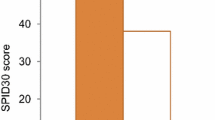Abstract
Background
Oral transmucosal fentanyl citrate (OTFC; ACTIQ) incorporates fentanyl into a lozenge allowing drug delivery through the oral mucosa resulting in rapid pain relief. OTFC is effective for breakthrough pain and could be particularly useful in patients with mucositis.
Methods
This randomized, double-blind, crossover study assessed two formulations of OTFC for tolerability in 14 patients with radiation-induced mucositis. On four separate days, patients with grade 3 or 4 mucositis received an OTFC unit 45 min before radiation treatment. Two units had a sweetened matrix formulation and two had a compressed powder formulation. One unit of each formulation contained 200 μg fentanyl and one was placebo. Tolerability, mucositis pain, and formulation preference were evaluated. Changes in oral mucosa were recorded.
Results
Both formulations of OTFC were well tolerated. There were no significant differences between formulations in tolerability, patient preference, or VAS pain scores. No changes in oral mucosa were noted. Common treatment-related adverse events included a burning sensation in the mouth, nausea, and vomiting.
Conclusions
Both formulations of OTFC are well tolerated. The presence of fentanyl in either the sweetened matrix or the compressed powder did not alter tolerability or safety. The dose of fentanyl tested did not yield analgesia greater than placebo; future studies of OTFC efficacy in mucositis should evaluate higher doses than 200 μg.
Similar content being viewed by others
References
Anderson PM, Ramsay NK, Shu XO, Rydholm N, Rogosheske J, Nicklow R, Weisdorf DJ, Skubitz KM (1998) Effect of low-dose oral glutamine on painful stomatitis during bone marrow transplantation. Bone Marrow Transplant 22(4):339–344
Cancer Therapy Evaluation Program (CTEP) (1999) Common Toxicity Criteria (CTC), Version 2.0. Division of Cancer Treatment and Diagnosis, National Cancer Institute, National Institutes of Health, Department of Health and Human Services, March 1998, p. 12
Capelli D, Santini G, De Souza C et al (2000) Amifostine can reduce mucosal damage after high-dose melphalan conditioning for peripheral blood progenitor cellautotransplant: a retrospective study. Br J Haematol 110(2):300–307
Christie JM, Simmonds M, Patt R et al (1998) Dose-titration, multicenter study of oral transmucosal fentanyl citrate for the treatment of breakthrough pain in cancer patients using transdermal fentanyl for persistent pain. J Clin Oncol 16:3238–3245
Coda BA, O’Sullivan B, Donaldson G, Bohl S, Chapman CR, Shen DD (1997) Comparative efficacy of patient-controlled administration of morphine, hydromorphone, or sufentanil for the treatment of oral mucositis pain following bone marrow transplantation. Pain 72(3):333–46
Collins JJ, Geake J, Grier HE, Houck CS, Thaler HT, Weinstein HJ, Twum-Danso NY, Berde CB. Patient-controlled analgesia for mucositis pain in children: a three-period crossover study comparing morphine and hydromorphone. J Pediatr 1996;129(5):722–728
Coluzzi PH, Schwartzberg L, Conroy JD et al (2001) Breakthrough cancer pain: a randomized trial comparing oral transmucosal fentanyl citrate (OTFC) and morphine sulfate immediate release (MSIR). Pain 91:123–130
Dunbar PF, Chapman CR, Buckley FP, Gavrin JR (1996) Clinical analgesic equivalence for morphine and hydromorphone with prolonged PCA. Pain 68:265–270
Farrar JT, Cleary, J, Rauck R, Busch M, Nordbrock E (1998) Oral transmucosal fentanyl citrate: randomized, double-blinded, placebo-controlled trial for treatment of breakthrough pain in cancer patients. J Natl Cancer Inst 90:611–616
Hollander M, Wolfe DA (1999) Nonparametric statistical methods. Wiley, New York p. 46
Lichtor JL, Sevarino FB, Joshi GP, Busch MA, Nordbrock E, Ginsberg B (1999) The relative potency of oral transmucosal fentanyl citrate (OTFC) compared with intravenous morphine in the treatment of moderate to severe postoperative pain. Anesth Anal 89(3):732–738
Portenoy RK, Payne R, Coluzzi P et al (1999) Oral transmucosal fentanyl citrate (OTFC) for the treatment of breakthrough pain in cancer patients: a controlled dose titration study. Pain 79:303–312
Acknowledgements
Supported by a grant from Cephalon, Inc., West Chester, Pennsylvania, USA.
Author information
Authors and Affiliations
Corresponding author
Rights and permissions
About this article
Cite this article
Shaiova, L., Lapin, J., Manco, L.S. et al. Tolerability and effects of two formulations of oral transmucosal fentanyl citrate (OTFC; ACTIQ) in patients with radiation-induced oral mucositis. Support Care Cancer 12, 268–273 (2004). https://doi.org/10.1007/s00520-004-0595-4
Received:
Accepted:
Published:
Issue Date:
DOI: https://doi.org/10.1007/s00520-004-0595-4




